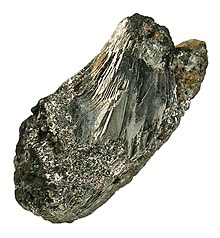| Rickardite | |
|---|---|
 Rickardite on tellurium Rickardite on tellurium | |
| General | |
| Category | Telluride mineral |
| Formula (repeating unit) | Cu7Te5 |
| IMA symbol | Rkd |
| Strunz classification | 2.BA.30 |
| Crystal system | Orthorhombic |
| Crystal class | Dipyramidal (mmm) H-M symbol: (2/m 2/m 2/m) |
| Space group | Pmmn |
| Identification | |
| Color | Red-violet (fresh), darkens |
| Mohs scale hardness | 3+1⁄2 |
| Luster | Metallic |
| Streak | Red |
| Diaphaneity | Opaque |
Rickardite is a telluride mineral, a copper telluride (Cu7Te5) or Cu3-x (x = 0 to 0.36)Te2. It was first described for an occurrence in the Good Hope Mine, Vulcan district, Gunnison County, Colorado, US, and named for mining engineer Thomas Arthur Rickard (1864–1953). It is a low temperature hydrothermal mineral that occurs associated with vulcanite, native tellurium, cameronite, petzite, sylvanite, berthierite, pyrite, arsenopyrite and bornite.
See also
References
- Warr, L.N. (2021). "IMA–CNMNC approved mineral symbols". Mineralogical Magazine. 85 (3): 291–320. Bibcode:2021MinM...85..291W. doi:10.1180/mgm.2021.43. S2CID 235729616.
- ^ Mindat
- ^ Handbook of Mineralogy
- Webmineral
- D. M. Chizhikov and V. P. Shchastlivyi, 1966, Tellurium and Tellurides, Nauka Publishing, Moscow
This article about a specific mineral or mineraloid is a stub. You can help Misplaced Pages by expanding it. |